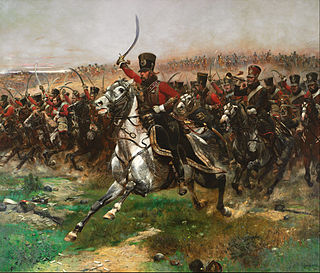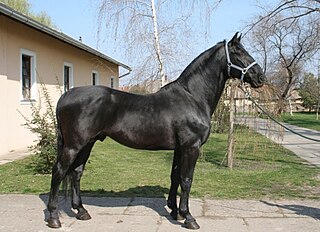
Historically, cavalry are soldiers or warriors who fight mounted on horseback. Cavalry were the most mobile of the combat arms, operating as light cavalry in the roles of reconnaissance, screening, and skirmishing in many armies, or as heavy cavalry for decisive shock attacks in other armies. An individual soldier in the cavalry is known by a number of designations depending on era and tactics, such as a cavalryman, horseman, trooper, cataphract, knight, drabant, hussar, uhlan, mamluk, cuirassier, lancer, dragoon, or horse archer. The designation of cavalry was not usually given to any military forces that used other animals for mounts, such as camels or elephants. Infantry who moved on horseback, but dismounted to fight on foot, were known in the early 17th to the early 18th century as dragoons, a class of mounted infantry which in most armies later evolved into standard cavalry while retaining their historic designation.

The Maremma is a coastal area of western central Italy, bordering the Tyrrhenian Sea. It includes much of south-western Tuscany and part of northern Lazio. It was formerly mostly marshland, often malarial, but was drained by order of Ferdinando I de' Medici.

Trakehner is a light warmblood breed of horse, originally developed at the East Prussian state stud farm in the town of Trakehnen from which the breed takes its name. The state stud was established in 1731 and operated until 1944, when the fighting of World War II led to the annexing of East Prussia by Russia, and the town containing the stud renamed as Yasnaya Polyana.

Warmbloods are a group of middle-weight horse types and breeds primarily originating in Europe and registered with organizations that are characterized by open studbook policy, studbook selection, and the aim of breeding for equestrian sport. The term distinguishes these horses from both heavy draft horses and refined light saddle horses such as the Thoroughbred, Arabian, and Akhal-Teke. Although modern warmbloods are descended from heavier agricultural types systematically upgraded by hotblood influence, the term does not imply that warmbloods are direct crosses of "cold" and "hot".

A lancer was a type of cavalryman who fought with a lance. Lances were used for mounted warfare in Assyria as early as 700 BC and subsequently by India, Egypt, China, Persia, Greece, and Rome. The weapon was widely used throughout Eurasia during the Middle Ages and the Renaissance by heavy cavalry, but fell out of general use by the late 16th century, before its revival by light cavalry in the early 19th century.

The Cleveland Bay is a breed of horse that originated in England during the 17th century, named after its colouring and the Cleveland district of Yorkshire. It is a well-muscled horse, with legs that are strong but short in relation to the body. The horses are always bay in colour, although a few light hairs in the mane and tail are characteristic of some breed lines. It is the oldest established horse breed in England. The ancestors of the breed were developed during the Middle Ages for use as pack horses, when they gained their nickname of "Chapman Horses". These pack horses were cross-bred with Andalusian and Barb blood, and later with Arabians and Thoroughbreds, to create the Cleveland Bay of today. Over the years, the breed became lighter in frame as they were employed more as carriage and riding horses. The popularity of the Cleveland Bay has greatly fluctuated since it was first imported to the United States in the early nineteenth century. Despite serious declines in the population after the Second World War, the breed has experienced a resurgence in popularity since the 1970s, although only around 550 horses existed worldwide as of 2006.

The Lusitano, also known as the Pure Blood Lusitano or PSL, is a Portuguese horse breed. Horses were known to be present on the Iberian Peninsula as far back as 20,000 BC, and by 800 BC the region was renowned for its war horses. The fame of the horses from Lusitania goes back to the Roman Age, which attributed its speed to the influence of the West wind, who was considered capable of fertilizing the mares. When the Muslims invaded Iberia in 711 AD, they brought Arabian horses with them that were crossed with the native horses, developing a horse that became useful for war, dressage and bull fighting. The Portuguese horse was named the Lusitano, after the word Lusitania, the ancient Roman name for the region that modern Portugal occupies. There are four main breed lineages within the breed today, and characteristics differ slightly between each line.

A buttero or cavalcante is a mounted herder, usually of horses, of cattle, or of buffaloes, in Italy, predominantly in the Maremma region of Tuscany and northern Lazio, or in the Pontine Marshes to the south.

The Russian Don is a breed of horse developed in and named after the steppes region of Russia where the Don River flows. Utilized originally as cavalry horses for the Cossacks, they are currently used for under-saddle work and driving.

The Maremmano-Abruzzese Sheepdog, also known as the Maremmano, Maremma Sheepdog, or Abruzzese Sheepdog, among other names, is an Italian breed of livestock guardian dog. It is indigenous to Central Italy, especially to the Maremma region of Tuscany and Lazio, and to northern areas of Southern Italy, particularly to Abruzzo. It has been used for centuries by Italian shepherds to guard sheep from wolves. The "Maremmano" name derives from that of the Maremma marshlands where, until recently, shepherds, dogs and hundreds of thousands of sheep over-wintered, and where the dogs are still abundant although sheep-farming has decreased substantially. However, the breed is still widely employed in and closely culturally associated with the nearby region of Abruzzo, where sheep herding remains vital to the rural economy and the wolf remains an active and protected predator.

The Ardennais or Ardennes is one of the oldest breeds of draft horse, and originates from the Ardennes area in Belgium, Luxembourg, and France. They are heavy-boned with thick legs and are used for draft work.

The Budyonny is a breed of horse from Russia. It was bred as a military horse after the Russian Revolution of 1917; in the twenty-first century it is used as an all-purpose competition horse and for driving.

The Maremmana is a breed of cattle reared in the Maremma, a former marshland region in southern Tuscany and northern Lazio in central Italy. It is raised principally in the provinces of Grosseto, Rome and Viterbo.

The American Warmblood is a horse of warmblood type, intended primarily for the traditional sport horse disciplines of dressage, show jumping, eventing and combined driving.

The Nonius is a Hungarian horse breed named after its Anglo-Norman foundation sire. Generally dark in color, it is a muscular and heavy-boned breed, similar in type to other light draft and driving horses. The breed was developed at the Imperial Stud at Mezőhegyes, Hungary by careful linebreeding. Originally bred to serve as a light draft and utility horse for Hungary's military, the breed became a useful agricultural horse during the 20th century. The depredations of World War II significantly reduced the Nonius' population, and in the decades after the war, a downturn in the usage of horses in Hungary sent many members of the breed to slaughter. Today the breed is bred by preservationists and is used in agriculture, leisure riding, and competitive driving sports. The largest numbers of Nonius horses are still found at Mezőhegyes, with representatives in other eastern European nations as well.

The Tolfetano or Cavallo Tolfetano is a breed of horse from the northern part of the Lazio region of Italy. It is indigenous to the Monti della Tolfa range of hills which lie within the Maremma Laziale, and which give the breed its name. The harsh terrain and limited resources of the area are thought to have contributed to the resistant and frugal nature of the breed.

The Persano is a horse breed created during the Kingdom of Naples at the Royal Stud of Persano near Serre in the Italian province of Salerno. It is similar in appearance to an Anglo Arabian and was created by crossing Andalusians, Arabians, Turkomans and Mecklenburgers.

The Cavallo Romano della Maremma Laziale, or "Roman horse of the part of the Maremma that is in Lazio", is a horse breed native to the Lazio region of Italy. An ancient breed, it was officially recognised only in 2010; it is now one of the fifteen indigenous horse "breeds of limited distribution" listed by the AIA, the Italian breeders' association. The Lazio region has assigned it the conservation status "at risk of erosion". The population numbers about 800, of which most are in the comune of Monte Romano in the province of Viterbo; a herd of approximately 200 is at Ponzano Romano in the province of Rome, and others are in the province of Rieti.

The Norman Cob or Cob Normand is a breed of light draught horse that originated in the region of Normandy in northern France. It is of medium size, with a range of heights and weights, due to selective breeding for a wide range of uses. Its conformation is similar to a robust Thoroughbred, and it more closely resembles a Thoroughbred cross than other French draught breeds. The breed is known for its lively, long-striding trot. Common colours include chestnut, bay and seal brown. There are three general subsets within the breed: horses used under saddle, those used in harness, and those destined for meat production. It is popular for recreational and competitive driving, representing France internationally in the latter, and is also used for several riding disciplines.




















